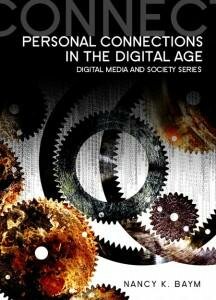
In her book, Personal Connections in the Digital Age, Nancy K. Baym describes exactly how we, in this current digital age, are still making personal connections. With six chapters and a conclusion addressing the myth of cyberspace, Baym walks readers through what personal connections can look like in relation to new media and addresses questions associated to mediated relationships.
Seven key concepts outlined in the book are purported by Baym as the key to understanding “how media influence personal connections” (p. 6). These include interactivity, temporal structure, social cues, storage, replicability, reach, and mobility. Baym draws on several specific issues in discussing these themes. For example, while referencing the concept of social cues, Baym explains that though it is a different process to create friendships online than offline, there are still many benefits. Cross-sex friendships specifically are more common online than offline because they do not fit the normal frame of offline friendships, but are widely accepted online. Additionally, the concept of reach is illustrated with a vivid example of how computer-mediated communication (CMC) enables more effective business practices.
Not only are all of these concepts well defined, examples are provided to further illuminate each one. Also, relevant theoretical approaches are clearly outlined. Theories such as Social Information Processing (SIP) and Social Identity Theory of Deindividuation (SIDE) are practically explicated in this text.
Indeed, while theoretical understanding is always essential, conceivably the most important contribution of Baym’s book is her argument that the societal backlash we are experiencing against current technologies (worries about safety, debates about the reality of online interactions), is in no way new. Take for example the public outcry that came when people started getting married through telegram. The parallel to online dating and questions about its validity is immediately brought to light. Here, we are led to understand that even though it seems like new technology leads to new problems, the opposite is actually true.
With her approachable writing style and clear summation of pertinent issues, Baym is able to appeal to both scholars inexperienced in the field and readers who have been researching personal relationships/CMC for years. The wide reach of Personal Connections in the Digital Age makes it applicable to many courses. For example, a communication course focusing on new technology could use this as a starting point to the course and many relevant discussions. Further, a more advanced course could use this text as an example of theories being practically applied to new and exciting issues in the communication field. Finally, an interpersonal communication course could make good use of this book while seeing how traditional interpersonal theories of relationship creation apply/don’t apply to this new way of making relationships.
Those not currently teaching such courses will also benefit from Baym’s book as it provides a solid understanding of an increasingly pertinent field. While not all scholars will encounter issues of personal relationships through digital media, surely their students will. Reading Personal Relationships in a Digital Age will not only inform readers of current issues, it may also spark a new research interest.
Review by Allyn McCalman, PhD student at the University of Kansas.
Add new comment